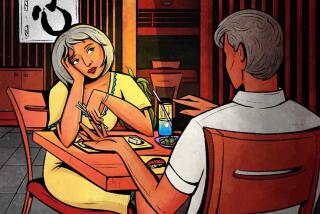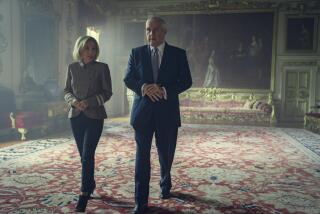Camilla: Always Ready to Comfort Prince Charles
- Share via
In 1972, Prince Charles met a woman who was to become not only very special to him, but perhaps the most important woman in his mature life. Her name was Camilla Shand. They were about the same age, he being 23 and she 22. Their involvement was like no other he had yet experienced. At first he wasn’t physically attracted to her. After all, she didn’t conform to his rather stereotyped image of the perfect woman. Camilla was not long-legged and blond. She was dark, animated and very bright. She had a quick mind and, more important, she understood Charles. She knew what made him smile or laugh, and she encouraged him to open his mind to her and talk without constraint.
Whenever they met, they simply spent the evening together locked in lively discussion, chatting as if they had known each other for years. He was not obliged to be rigid or formal, for she was not a girlfriend. Rather, she was a real friend, a companion with whom he could relax and be himself. And for Charles, that was rare indeed.
When she first met Charles, she was dating an officer in the Household Cavalry, Capt. Andrew Parker Bowles, a polo-playing friend of Charles 10 years her senior.
The more Charles saw of Camilla, the more intrigued he became. He realized that she was indeed a real woman, the likes of which he had never known before. The prince was smitten.
It was not known whether Camilla and Charles became lovers in those early months, but whenever they were seen together, an exhilarating, animated intensity existed between them. They were acting, in short, like a couple in love.
Camilla adored being the subject of a great deal of attention from the heir to the throne. They had fun together, and she knew they had become sexually attracted to each other, but she had no idea whether Charles would translate his affection into marriage.
He had already explained that he would have to remain at sea for some years and that he didn’t intend to marry straightaway. First he had to settle down into civilian life and take more of the burden of royalty off his mother’s shoulders. He told Camilla all this, but he failed to mention that he was in love with her and wanted her to be his wife--and the next queen of England.
Charles still hadn’t learned the communications skills needed in love and courtship. He hadn’t yet grasped that being in love required more than just a demonstration of feeling when he was with the woman he desired. Relationships needed nurturing and thought, and intentions had to be spelled out. Unaware that he had to express his love, Charles stayed away at sea, occasionally writing open, friendly and amusing letters to Camilla that were largely devoid of passion or feeling.
Camilla was still being wooed by her cavalry officer, who had just been promoted to major. She enjoyed life in London with Andrew Parker Bowles’ fellow officers and their wives and girlfriends. She knew she could look forward to a full, happy life as the wife of an officer in the elite Brigade of Guards. Her family was affluent, so she would never want for money.
In February, 1973, Charles and Camilla exchanged a tearful farewell in his rooms at Buckingham Palace. He was about to go to sea for six months on HMS Minerva and though he wanted to tell Camilla to wait for him, he couldn’t ask her. He simply didn’t know what to do: suggest that she wait in the hope that one day they might wed or let life take its course.
Charles sailed from Portsmouth feeling a deep sense of loss. One month later, the engagement of Camilla Shand and Maj. Andrew Parker Bowles of the Blues and Royals (a household cavalry regiment with the Life Guards makes up the Queen’s elite mounted escort) was announced in the London Times.
The wedding of Camilla to his good friend Andrew cast a shadow over Charles’ life. In the months immediately before and after Camilla’s wedding, Charles confided in his brother officers on Minerva that he was “very fond” of a young woman, but he never revealed her name. Certainly he wouldn’t have confessed that she was not only married, but the wife of a fellow officer and friend. But he still carried a torch.
Charles tried to forget Camilla. He was determined to forgo seeing her. His upbringing and sense of fair play forced him to reject her because she was the wife of another man. But the bond between them was too strong.
They kept meeting by chance at social functions in London or weekend house parties in the country. Inevitably, they would spend much of the time in conversation with each other, seemingly oblivious to all around them. It was clear to everyone that they enjoyed laughing together and being in each other’s company. Their friendship deepened.
Now that Charles and Diana are living apart, Camilla spends days and nights at Highgrove whenever Charles is at his country house, which has become his principal home. (Diana lives at Kensington Palace in London.) Camilla hosts dinners and lunches for Charles, sits beside him at table, organizes his personal life, checks the menus and the guest lists, organizes the staff, kitchen and the chefs. Most important, she is the only person Charles allows inside his walled vegetable garden. Indeed, Charles only permits Diana and his own two sons to enter the garden on special occasions, which are infrequent.
Camilla lives just 15 miles from Highgrove in beautiful Middlewick House in Wiltshire, where she stables her beloved horses. Like Charles, she prefers to spend most of her time in the country, while husband, Andrew, stays most weeks in London, returning to the country on weekends.
Camilla is always ready to comfort the prince. The evening Charles was discharged from the hospital after breaking his arm in a polo fall, he went immediately to Highgrove to convalesce. Within the hour, Camilla arrived to care for him.
Many believe that Andrew Parker Bowles should be jealous, if not enraged, by his wife’s close friendship with Charles. Those who know him well, however, reveal that Andrew recognizes that Charles needs someone like Camilla who can understand and relate to him, comfort and cherish him in his loneliness. He also sees there is a certain mutual attraction, compatibility and great intimacy between them. As a fellow officer in the Brigade of Guards, he believes he should accommodate the role his wife is playing for the prince and apparently does so quite happily.
In earlier times--at the beginning of this century, for example--husbands were obliged to believe it was a privilege if the king or prince of Wales showed interest in their wives. Others considered it their duty to the royal family to stand aside while the prince, whoever he was, courted their wives or even engaged in open, passionate affairs with them. We can only speculate how late into the 20th Century these attitudes endured.
In May, 1991, Charles went on a weeklong solo painting holiday to Tuscany, at a hideaway villa near Florence. At the same time Camilla flew out to Italy, leaving Brigadier Andrew Parker Bowles, then director of the Royal Army Veterinary Corps, alone in Britain. Camilla spent several days at a villa just 30 minutes’ drive from where Charles was staying.
Camilla is also a frequent guest at Balmoral, sometimes with her husband and sometimes without him. Despite being 10 years his senior, Andrew has been close friends with Charles for more than 20 years. They used to play polo together. Camilla and Andrew have been married for 19 years and have two children.
Very few people knew of the relationship between Charles and Camilla. The press certainly did not know until many years later. Naturally, Charles told Uncle Dickie (the late Lord Louis Mountbatten, his favorite relative and confidant), who advised him to keep it low-key, imploring him not to bring it out into the open. But Mountbatten did not urge him to give up Camilla; he only cautioned him to be discreet.
Both Charles and Mountbatten had long been fascinated by the trauma of nearly 40 years before, when the prince’s great-uncle, Edward VIII, had given up the throne for the love of an American divorcee, Wallis Simpson. Mountbatten undoubtedly saw parallels between Charles and the love-struck Edward.
If Charles ever considered asking Camilla to divorce her husband and marry him after a respectable lapse of time, one thing would have stopped him--the one trait he possesses in abundance that the duke of Windsor did not: a sense of duty. He wanted Camilla, and he realized that he was going to find it very difficult, it not impossible, to meet another woman like her. But there was no question of his giving up the throne for her. Reared with a remarkable sense of duty and loyalty to his mother, to the crown and to the traditions of monarchy, even contemplating such a possibility would have been insupportable.
TUESDAY: The other man in Diana’s life.


